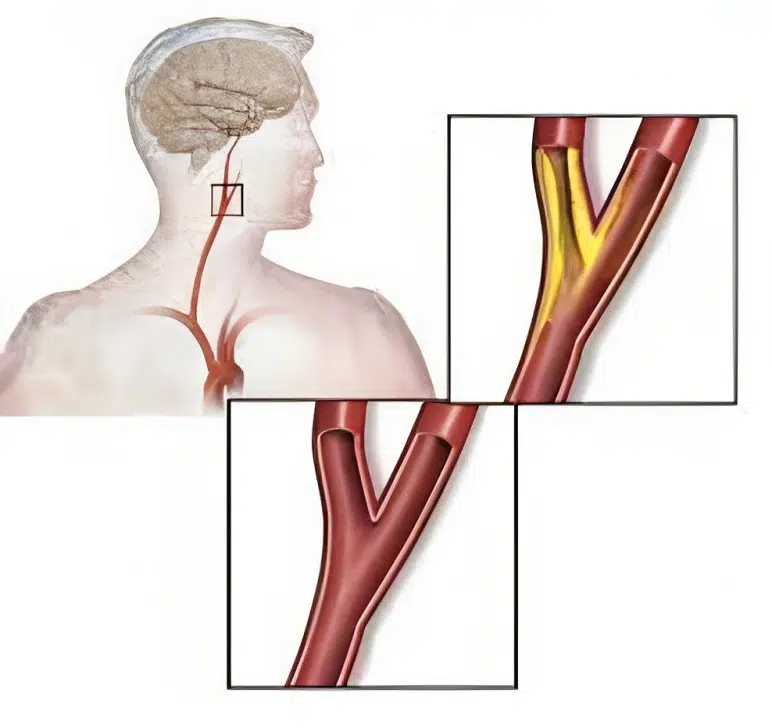Carotid Atheroma: A Major Cause of Stroke and How to Prevent It in 2023

Carotid atheroma is a medical term that refers to the buildup of fatty material or plaque inside the carotid arteries. These are the two main arteries that supply blood to the brain. Carotid atheroma can cause the arteries to narrow and harden, reducing the blood flow to the brain. This can lead to serious health problems such as stroke and transient ischemic attacks (TIAs). Here, we will explain what carotid atheroma is, what are its types, risk factors, symptoms, and treatments. We will also give you some tips on how to prevent carotid atheroma and protect your brain health in 2023.
What are the Types of Carotid Atheroma?
There are two main types of carotid atheroma:
- Stable carotid atheroma: This type of plaque is stable and does not cause any symptoms. It is usually found during routine medical examinations or imaging tests such as ultrasound, computed tomography (CT), magnetic resonance imaging (MRI), or angiography. Stable carotid atheroma may not require any treatment unless it causes significant narrowing of the artery or poses a high risk of rupture.
- Unstable carotid atheroma: This type of plaque is unstable and can rupture or break off, causing a blood clot to form. This can block the blood flow to the brain and cause a stroke or TIA. A stroke is a medical emergency that occurs when a part of the brain is deprived of oxygen and nutrients for more than a few minutes. A TIA is a temporary stroke that lasts for less than 24 hours and does not cause permanent damage to the brain. However, both stroke and TIA can cause serious symptoms such as sudden weakness, numbness, vision loss, speech difficulty, or confusion. Unstable carotid atheroma requires urgent treatment to prevent further complications.
What are the Risk Factors for Carotid Atheroma?
Carotid atheroma is influenced by both genetic and environmental factors. Some of the factors that increase the risk of developing carotid atheroma are:
- Age: The risk of carotid atheroma increases with age as the arteries become less elastic and more prone to damage.
- Sex: Men are more likely to develop carotid atheroma than women due to hormonal differences.
- Smoking: Smoking damages the lining of the arteries and increases inflammation and oxidative stress in the body. It also lowers HDL (good) cholesterol and raises LDL (bad) cholesterol levels in the blood.
- High blood pressure: High blood pressure puts extra strain on the walls of the arteries and causes them to thicken and stiffen. It also increases the risk of plaque rupture and blood clot formation.
- High cholesterol: High cholesterol levels in the blood contribute to the formation of plaque in the arteries. LDL cholesterol is especially harmful as it can penetrate the lining of the arteries and accumulate in the wall. HDL cholesterol is beneficial as it can remove excess cholesterol from the arteries and transport it to the liver for excretion.
- Diabetes: Diabetes causes high blood sugar levels that damage the lining of the arteries and increase inflammation and oxidative stress in the body. It also lowers HDL cholesterol and raises triglycerides (another type of fat) levels in the blood.
- Family history: Having relatives who have had heart disease or stroke at an early age increases the risk of inheriting genes that predispose to carotid atheroma.
- Other factors: Other factors that may increase the risk of carotid atheroma include obesity, physical inactivity, stress, inflammation, infection, and certain medications.
What are the Symptoms of Carotid Atheroma?
The most common symptom of carotid atheroma is a TIA. TIAs are temporary strokes that cause symptoms such as sudden weakness, numbness, vision loss, speech difficulty, or confusion on one side of the body or face. These symptoms usually last for less than an hour and then disappear completely. However, TIAs are warning signs that indicate a high risk of having a full-blown stroke in the future. Therefore, it is important to seek medical attention immediately if you experience any signs of TIA.
Other symptoms of carotid atheroma may include:
- Neck pain or tenderness
- Headache
- Dizziness
- Vertigo (a sensation of spinning)
- Difficulty concentrating
- Difficulty remembering things
- Changes in personality or mood
Diagnostic Methods of Carotid Atheroma
The main diagnostic methods for carotid atheroma are:
- Carotid ultrasound: This is a noninvasive test that uses sound waves to create images of the carotid arteries. It can be used to detect plaques, blockages, and narrowing of the arteries.
- Computed tomography angiography (CTA): This is a type of CT scan that uses a contrast dye to create detailed images of the carotid arteries. It can be used to measure the severity of blockages and to determine if there are any other abnormalities in the arteries.
- Magnetic resonance angiography (MRA): This is a type of MRI scan that uses a magnetic field and radio waves to create images of the carotid arteries. It is similar to CTA, but it does not use radiation.
- Cerebral angiography (carotid angiogram): This is an invasive procedure that involves injecting a contrast dye into an artery in the arm or groin. The dye travels through the bloodstream to the carotid arteries, where it can be seen on X-ray images. This test is rarely needed today, but it is still considered the gold standard for diagnosing carotid atheroma.
What are the Treatments for Carotid Atheroma?
The treatment for carotid atheroma depends on the severity of the condition and the patient’s overall health. Treatment options may include:
- Lifestyle changes: Lifestyle changes such as quitting smoking, eating a healthy diet, exercising regularly, and controlling blood pressure can slow the progression of carotid atheroma and reduce the risk of stroke and TIA. A healthy diet should include fruits, vegetables, whole grains, lean proteins, low-fat dairy products, nuts, seeds, and healthy oils. It should also limit saturated fat, trans fat, cholesterol, salt, and sugar intake. Physical activity should be moderate to vigorous and last for at least 30 minutes a day, five days a week. Blood pressure should be checked regularly and kept within the normal range (less than 120/80 mmHg).
- Medications: Medications such as statins, blood pressure medications, and antiplatelet medications can reduce the risk of complications from carotid atheroma. Statins are drugs that lower cholesterol levels in the blood and prevent plaque formation in the arteries. Blood pressure medications are drugs that lower blood pressure and prevent damage to the arteries. Antiplatelet medications are drugs that prevent blood clots from forming and reduce the risk of stroke and TIA. These medications may have side effects and interactions with other drugs, so they should be taken under the supervision of a doctor.
- Surgery: Surgery may be recommended for patients with severe carotid atheroma that is at risk of rupturing or causing a stroke. There are two main types of surgery for carotid atheroma:
- Carotid endarterectomy: This is a surgical procedure that involves making an incision in the neck and removing the plaque from the carotid artery. This restores the blood flow to the brain and reduces the risk of stroke and TIA. The surgery may take one to two hours and requires general or local anesthesia. The recovery time may vary from a few days to a few weeks.
- Carotid angioplasty and stenting: This is a minimally invasive procedure that involves inserting a thin tube called a catheter into the groin or arm and guiding it to the carotid artery. A balloon is then inflated at the tip of the catheter to widen the narrowed artery. A metal mesh called a stent is then placed inside the artery to keep it open and prevent it from narrowing again. The procedure may take one to two hours and requires local anesthesia. The recovery time may be shorter than carotid endarterectomy.
How to Prevent Carotid Atheroma in 2023?
Carotid atheroma is a common condition that can lead to serious health problems such as stroke and TIAs. However, there are effective treatments available to slow the progression of the disease and reduce the risk of complications. If you have any of the risk factors for carotid atheroma, it is important to talk to your doctor about your risk and how to reduce it.
Some of the preventive measures that you can take in 2023 are:
- Quit smoking or avoid exposure to secondhand smoke
- Eat a balanced diet that is low in fat, salt, sugar, and cholesterol
- Increase your intake of fiber, antioxidants, omega-3 fatty acids, and other nutrients that support arterial health
- Exercise regularly and maintain a healthy weight
- Manage your stress levels and practice relaxation techniques
- Monitor your blood pressure, cholesterol, blood sugar, and other vital signs regularly
- Take your medications as prescribed by your doctor
- Follow up with your doctor regularly and undergo screening tests for carotid atheroma if recommended
- Seek medical attention immediately if you experience any symptoms of stroke or TIA
By following these tips, you can prevent carotid atheroma and protect your brain health in 2023. Remember that prevention is better than cure and that you have the power to make positive changes in your life.
